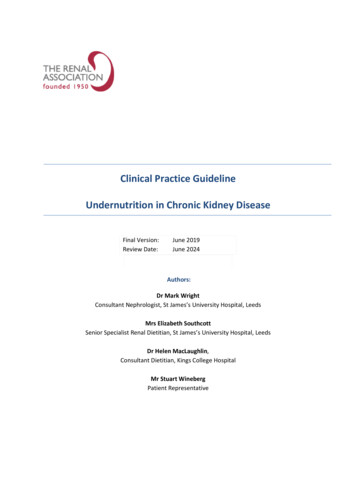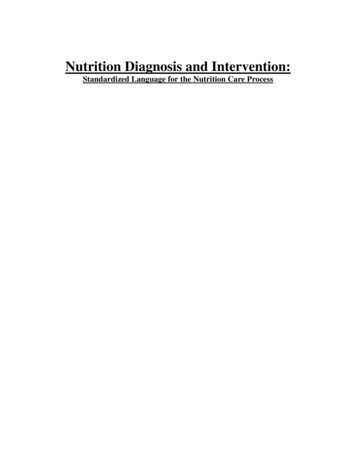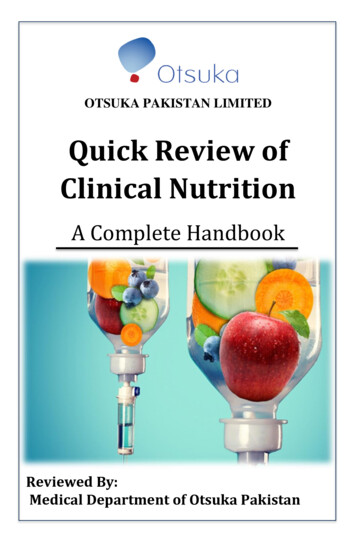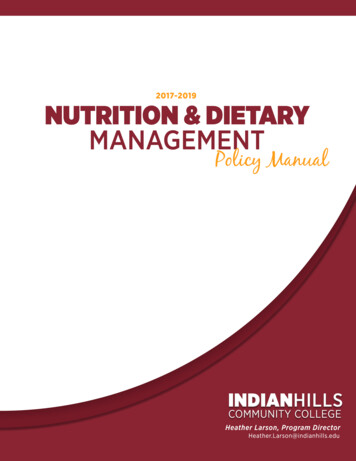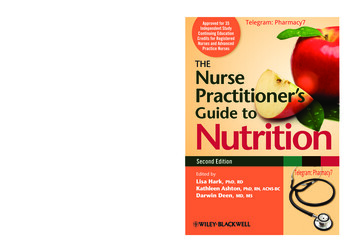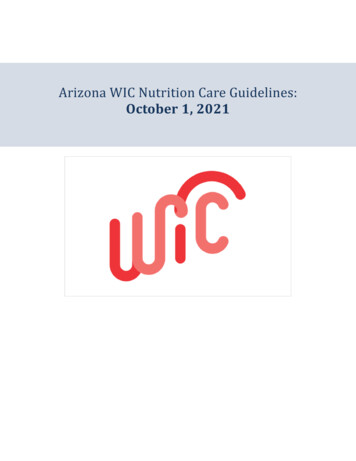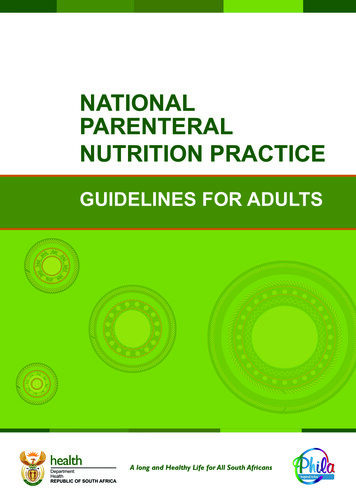
Transcription
National Total Parenteral Nutrition Practice Guidelines for AdultsNATIONALPARENTERALNUTRITION PRACTICEGUIDELINES FOR ADULTSA long and Healthy Life for All South Africans1
National Total Parenteral Nutrition Practice Guidelines for AdultsCopyright - 2016national Department of Health, South AfricaThis publication is intended to support nutrition activities and may be freely quoted,reproduced and distributed, provided that the source is acknowledged.Distribution for remuneration is not permitted.Permission from the copyright holder is required for changes to the format of this publication.Prepared and obtainable free of charge from:Directorate: Nutritionnational Department of HealthPrivate Bag X828Pretoria0001Tel: (012) 395 9621Fax: 086 632 8484Department of Health – 2016www.health.gov.za2
National Total Parenteral Nutrition Practice Guidelines for AdultsTable of contentsAcknowledgements. 5Acronyms. 61.Definitions. 72.Introduction. 81.1 Purpose of the nutrition guideline. 81.2 Goals and objectives of document. 83.Roles and responsibilities within the nutrition therapy team. 84.Indications and contraindications of parenteral nutrition . 95.Nutritional assessment of patients. 105.1 Anthropometric data 105.2 Biochemical data 105.3 Clinical 105.4 Diet history 115.5 Medication 116.Nutritional recommendations116.1Macronutrients 116.1.1 Refeeding syndrome 116.1.1.1 Identification of patient at risk of developing refeeding syndrome116.1.2 Management of patients at risk of developing refeeding126.2 General and disease specific requirements136.3 Micronutrients 217.Nutritional intervention 227.1Medical nutrition therapy 227.1.1 Parenteral nutrition product formulations 227.1.2 Administration of parenteral nutrition 237.1.3 Safety 248.Patient monitoring and complications 258.1Monitoring 258.2Complications 268.3 Weaning from parenteral nutrition 289.Summary 2810. Monitoring and evaluation assessment tool 2811. References 2913. Addenda13.1 Addendum 1: Parenteral nutrition monitoring checklist31List of TablesTable 1: Recommended composition of the NTT 8Table 2: Indications and contra-indications for parenteral nutrition9Table 3: Guidelines of the NHICE for identifying patients11Table 4: Regimen for management of refeeding syndrome: Applicable to enteral and parenteral nutrition12Table 5: Monitoring 12Table 6: Recommendations for electrolyte replacement 12Table 7: Disease specific requirements13Table 8: Suggested composition of parenteral multivitamin and trace-element products for adults21Table 9: Comparison between parenteral nutrition solutions available in South Africa22Table 10: Comparison of administration methods 23Table 11: Monitoring of parenteral nutrition patients 25Table 12: Complications 263
National Total Parenteral Nutrition Practice Guidelines for AdultsList of FiguresFigure 1:Weaning algorithm 364
National Total Parenteral Nutrition Practice Guidelines for AdultsAcknowledgementsThe National Adult Parenteral Nutrition Practice Guidelines will assist in providingstandardised and quality nutrition services to patients attending public healthinstitutions. The provision of adequate and appropriate nutrition in hospitalsis imperative in building and maintaining individual nutritional status and thusdecreasing hospital length of stay.The national Department of Health would like to express its sincere gratitude toall national and provincial departments for their contribution to the developmentof these guidelines. Thanks are extended to Hiliary Goeiman for her assistancein providing a core clinical working group within the Western Cape for thedevelopment of this document. Special thanks to the core technical team for theirtechnical input, commitment and dedication, which contributed to the developmentof this document. The following members were instrumental in this process:Anna-Lena Du Toit: Dietitian – Western Cape Department of HealthProf. Renée Blaauw: Lecturer – Stellenbosch UniversityNolene Naicker: Assistant Director – national Department of HealthLuzette Van Niekerk: Assistant Director – Western Cape Department of HealthCharne de Lange: Dietitian – Western Cape Department of HealthRepresentatives from the University of Stellenbosch, the Directorate: Affordable Medicines and the National EssentialMedicines List Committee, the Critical Care Society of Southern Africa, the South African Society for Parenteral andEnteral Nutrition in South Africa and provincial nutrition units contributed to the development of these guidelines and wethank them for their time and technical inputs.MP MatsosoDirector-General: Health5
National Total Parenteral Nutrition Practice Guidelines for PONTTPNPVTRDAREESIRSTETPNaromatic amino acidsacute kidney injuryartificial nutrition and hydrationbranched chain amino acidsbone mineral densitybody mass indexcontinuous ambulatory peritoneal dialysiscentral line associated blood stream infectioncontinuous renal replacement therapycentral venous cathetercentral venous portdual energy X-ray absorptiometrydietary reference intakeelectrocardiographicenteral nutritionfull blood countglomerular filtration rategastrointestinal tracthaemodialysishome parenteral nutritionideal body weightintermittent haemodialysisinternational normalised ratiomultiple organ dysfunction syndromeNational Institute for Health and Care Excellencenon-protein energynil per osnutrition therapy teamparenteral nutritionperipheral vein thrombosisrecommended dietary allowanceresting energy expendituresystemic inflammatory response syndrometotal energytotal parenteral nutrition6
National Total Parenteral Nutrition Practice Guidelines for Adults1.1 DefinitionsAdult: An individual over the age of 18 years.All-in-one parenteral nutrition bag:All macro- and micronutrients to meet the recommended dietaryallowance are contained in one bag.Enteral nutrition:Parenteral nutrition:Nutrition therapy administered via a feeding tubeThe intravenous infusion of amino-acid (protein) solutions, hypertonicglucose, lipid emulsions, electrolytes, vitamins and trace elementsinto a central vein. Parenteral nutrition may, however, under specifiedconditions, be administered peripherally.Supplemental parenteral nutrition:Supplemental parenteral nutrition is used as an adjunct therapy toenteral nutrition in patients.Total parenteral nutrition:It serves as the sole source of nutrition for the individual.Three chamber parenteral nutrition bags:This bag contains macronutrients in separate pouches. Macronutrientsare combined prior to use by rolling the bag to break the seals,allowing macronutrients to mix. These bags do not contain all requiredmicronutrients in sufficient amounts.7
National Total Parenteral Nutrition Practice Guidelines for Adults22.Introduction2.1 Purpose of the nutrition guidelineThe aim of this guideline is to provide recommendations based on current evidence for best practice in the managementof parenteral nutrition by health professionals and care workers for all adult patients receiving parenteral nutrition therapyin government health facilities.It is outside the scope of this guideline to provide extensive clinical recommendations for nutrition requirements of allclinical states seen. However, a general overview of nutrition requirements has been provided.2.22.2 Goals and objectives of the documentEnteral nutrition (EN) should always be the first option when feeding a patient whom is not able to consume adequatefood orally. Parenteral nutrition (PN) should be used when the gastrointestinal tract (GIT) is not available or not able toabsorb nutrients supplied on a short or long term basis. PN can be used either alone or in combination with enteral ororal foods to meet patients’ estimated nutrition requirements.Goals and objectivesThe goals and objectives of this guideline is to ensure:1. optimal and standardised use of PN2. effective use of PN3. that staff is aware of the coordinated policy regarding PN3. Roles and responsibilities within the nutrition therapy teamIt is recommended that nutrition therapy teams (NTT) be established in each facility to ensure that all the goals are met.The core NTT is indicated in Table 1.Table 1: Recommended composition of the NTTMemberTaskDietitianDietary prescription, coordinator, request of biochemistryPharmacistProcurement and safe compoundingSurgeon/physician/doctorPrescribing privileges. Liaison with dietitian regarding prescription,request of biochemistry, correction of electrolytes (refeeding syndrome)Professional nurse in wardAdministration, care and recording of PNOtherMore medical and paramedical members may be added as needed8
National Total Parenteral Nutrition Practice Guidelines for Adults4. Indications and contraindications of PNIndications and contraindications for PN are summarised in Table 2. Patients should be fed because starvation andunderfeeding of patients is associated with a higher incidence of morbidity and mortality.1 All patients who are expectednot to tolerate oral or adequate enteral nutrition (minimum 60 per cent of requirements) by day three to five should bestarted on PN as soon as possible post admission.1 Early nutrition intervention and introduction of PN is especiallynecessary in patients with pre-existing malnutrition.2,3PN should, however, be administered with care, which includes appropriate monitoring and adherence to standards andtechniques associated with aseptic techniques.4Table 2: Indications and contraindications for PN3Usual indications high dose chemotherapysevere malnutrition with a non-functional GITsevere catabolism in the presence of malnutrition and a nonfunctional GIT for 3-5 daysmalnutrition (intensive surgery)GI route not available for 3-5 daysdocumented inability to absorb adequate nutrients from theGI tract:o massive small bowel resections/short bowel syndrome.(PN should be indicated in the initial period at least)o radiation enteritiso severe diarrhoeao untreatable steatorrhea/malabsorption – if pancreaticinsufficiency, small bowel bacterial overgrowth andceliac disease have been ruled outcomplete bowel obstructionsevere catabolism with or without pre-existing malnutritionwhere enteral feeding is not possible for 5 – 7 daysinability to obtain enteral accessinability to provide sufficient nutrients enterallypersistent GI haemorrhageAcute abdomen /prolonged ileuswork-up requiring nil per os (NPO) status for several days ina patient with pre-existing malnutritionhigh output enterocutaneous fistula ( 500ml per 24hrs) withinability to gain enteral access distal to fistula site or if enteralfeeding worsens fistula outputtrauma requiring repeat surgical procedures and lengthyperiods of NPO statusRelative indications high dose chemotherapyenterocutaneous fistula ( 500ml outputper 24hrs)hyperemesis gravidarium when nauseaand vomiting persists for 5 – 7 days andenteral feeding is not possiblepartial small bowel obstructionsevere mucositisintractable vomiting when small bowelfeeding is not possiblechylous ascitis or chylothorax when low fator fat free enteral nutrition does not reduceoutput adequatelyabdominal compartment syndromemoderate to severe acute pancreatitis orpancreatitis accompanied by abdominalpain with jejunal feedingContraindications functional GITneedforemergencysurgerypatient refusalprognosisthatdoesnot warrant aggressivenutritionsupportinterventionPN risk exceeds potentialbenefitsinability to obtain venousaccessArtificial nutrition is regarded as medical nutrition therapy and thus subject to all the ethical dilemmas and debatesregarding treatment. Patient consent needs to be obtained before commencement of nutrition therapy, in this case PN.Healthcare professionals are not ethically obligated to provide artificial nutrition and hydration (ANH) in cases of endof-life situations or “futile care”, if healthcare professionals establish that there is not enough evidence for providingnutrition therapy or if the risk of nutrition intervention outweighs its benefit.2,5A clear indication for the need for PN, and where possible a small amount of enteral or oral feeding, should be consideredin order to maintain the integrity of the gastrointestinal tract and reduce the risk of hepatobiliary complications bystimulating gall bladder contractility. 1,2,3The use of minimal enteral feeding in all intensive care patient populations is recommended, where possible. 1,2,3Patients with uncontrolled cardiac failure and electrolyte imbalances should be stabilised prior to the commencementof PN. 2,39
National Total Parenteral Nutrition Practice Guidelines for Adults5.Nutritional assessment of patientsAn initial assessment of all patients should be done by an appropriate qualified nutrition expert e.g. dietitian beforecommencement of any PN in order to determine goals of nutrition therapy. Within this assessment a number of keyquestions should be asked: 1,2,3,6,71.2.3.Is the nutrition therapy intended to maintain or replete body composition?Is PN required for short (less than two weeks) or long term?Are there any pre-existing medical conditions which may impact on substrate utilisation? A clear indication for the need for PN and where possible a small amount of enteral or oral feeding should beconsidered in order to maintain the integrity of the gastrointestinal tract and reduce the risk of hepatobiliarycomplications by stimulating gall bladder contractility. 1,2,3 In intensive care patients on PN the use of minimal enteral feeding is recommended, where possible. 1,2,3 Patients with uncontrolled cardiac failure and electrolyte imbalances should be stabilised prior to the commencementof PN. 2,3 Cognisance of organ dysfunction and other medical disorders should be accounted for in the patients’ medical notese.g. renal, cardiac, hepatic and respiratory. 2,3 The patients’ hydration status should be assessed with documentationof any ascites or edema.3Concomitant drug therapy and possible interactions with respect to the provision of nutrients and electrolytes andtheir requirements should be considered. 3Note: Information about the functional status of a patient is important as it helps to determine the patient’snutrition requirements. Mobile patients will have increased nutrition requirements compared to the immobile/ventilated patients.5.1 Anthropometric data:3 current weightcurrent height or substitute measure e.g. arm spanrecent changes in weightlevel of oedemaNutritional status in patients requiring PN will vary and it is therefore important to assess their metabolic and nutritionprofile with care. Information about appetite and weight change is important and should be elicited from the patientwhere possible. 6,75.2 Biochemical data:3 full blood countNa, K, Cl, urea, creatininecalcium, magnesium, phosphateserum triglyceridesserum glucoseliver function tests, including international normalised ratio (INR)c-reactive proteinalbumin –Should not be used as an independent criterionBaseline laboratory data is vital and should be reviewed prior to the commencement of PN. In the severely malnourishedor stressed patient, particular importance should be placed on the need for information regarding potassium, magnesium,calcium, phosphate, haemoglobin and coagulation. In those patients requiring long term PN, information about othertrace elements will be required, as well as liver function tests.1,2,35.3 Clinical:3A thorough history of the medical condition and anticipated treatment plan should be reviewed before the PN prescriptioncan be compiled. Special attention should be given to the following: diagnosis anatomy – resections, ostomies or previous surgery pre-existing conditions – e.g. diabetes mellitus, renal failure, liver disease10
National Total Parenteral Nutrition Practice Guidelines for Adults organ function treatment planFollow a structured approach to assess clinical signs of nutritional deficiencies, oedema, ascites and muscle wasting.5.4 Diet history:3 food/drug allergies or intolerancesdietary intake prior to hospital admissionperiod nil per mouth within hospital/when was last meal takenspecial dietary needs interventionsdrug-nutrient interactionsherbal/supplement use5.5 Medication:3 home and current medication assess for any drug interactions or drug induced deficiencies6.Nutritional recommendationsThe dietitian is responsible for the calculation of the individualised nutritional requirements of all patients. Diseasespecific guidelines are used and daily adaptations are made to the prescription.Nutrition requirements with respect to the patients’ clinical condition with regards to sepsis, severe malnutrition and orother factors should be determined. Each patient should have a nutrition prescription calculated by an appropriatelyqualified nutrition expert e.g. . Each nutrition prescription should include at least the following information: patient name hospital number ward date PN code prescribed total volume/administration rate route of administration (centrally or peripherally)It is recommended that the responsible NTT member facilitates the placement of the PN prescription via pharmacyusing a PN prescription schedule, which the medical doctor must sign. The aim of this process is to ensure that PN isadministered to patients in an appropriate and coordinated manner.6.1 Macronutrients6.1.1 Refeeding syndrome:6.1.1.1 Identification of patient at risk of developing refeeding syndrome:These guidelines have been adopted from the National Institute for Health and Care Excellence (NICE) guidelines foridentifying patients at high risk of developing refeeding syndrome. Guidelines are set out below in Table 3:Table 3: Guidelines for identifying patients at high risk for refeeding syndromePatient presents with ONE or more of the following: body mass index 16unintentional weight loss 15% in the past 3 – 6 monthslittle or no nutritional intake for 10 dayslow levels of potassium, phosphate or magnesium before initiating feedsOR, the patient presents with TWO or more of the following: body mass index 18,5unintentional weight loss 10% in the past 3 – 6 monthslittle or no nutritional intake for 5 dayshistory of alcohol misuse or drugs, including insulin, chemotherapy, antacids or diuretics11
National Total Parenteral Nutrition Practice Guidelines for Adults6.1.2 Management of patients at risk of developing refeeding syndromeTable 4: Regimen for management of refeeding syndrome: Applicable to EN and PN 8,9DayCalorie intakeSupplements and electrolytesMonitoring110 kcal/kg/day or5 kcal/kg/day in patients with BMI 14 orno food 15daysCHO: 50 – 60%Fat: 30 – 40%Protein: 15 – 20%Prophylactic supplements (unless high pre-feedingplasma levels): PO42-: 0,5 – 0,8mmol/kg K : 1 – 3 mmol/kg Mg2 : 0,3 – 0,4 mmol/kg Na : 1 mmol/kg IV Thiamine 200 – 300mg stat Vitamin B complex30 minutes prior to feeding do baseline biochemistry(urea, creatinine, Na , K , Cl-,Ca2 , Mg2 and PO42-. AlsoLFTs if not done recently) 2-45-7increase by 5 kcal/kg/day or continueminimal feeding if patient has lowtolerance, thus do not increase ifbiochemical shifts occurred. Supplementand repeat 20 – 30 kcal/kg/day 30 kcal/kg/day or increase to fullrequirements 8-10correct biochemistry abnormalities. See Table 6Thiamine 100mg Vitamin B-complexsupplementation, oral or IV. Continue until day 10 correct biochemistry abnormalities. See Table 6Thiamine 100mg Vitamin B-complexsupplementation, oral or IV. Continue until day 10consider iron supplementation from day 7 continue Thiamine 100mg and B complexsupplementation until day 10 repeat biochemistry after4 – 6 hoursmonitor biochemistry dailymaintain zero fluid balancemonitor according to Table5 dailycorrection of electrolytesand fluid balance shouldbe done along with feedingcheck biochemistrydaily and correct anyabnormalitiesmaintain zero fluid balancemonitor according to Table5 dailycheck biochemistrydaily and correct anyabnormalitiesmaintain zero fluid balancemonitor according to Table5 dailycheck biochemistry twiceweeklymonitor according to Table5 dailyTable 5 Monitoring 8Clinical monitoring: monitor blood pressure and pulse ratemonitor feeding ratestrict documentation of fluid balancemonitor changes in body weightclinical examination: oedema, blood pressure, pulse rate, cardiovascular and respiratory systems3monitor for neurological signs and symptomspatient educationBiochemical monitoring: monitor biochemistry and electrolytesmonitor blood glucose levelselectrocardiographic (ECG) monitoring in severe casesaccount for other sources of energy (e.g. dextrose, propofol, medication)Table 6 Recommendations for electrolyte replacement10Phosphate (0,8 – 1,45 mmol/l)Maintenance requirement0,3 – 0,6 mmol/kg/day orallyMild hypophosphataemia (0,6 – 0,85mmol/l)0,3 – 0,6 mmol/kg/day orallyModerate hypophosphataemia (0,3 – 0,6mmol/l)9 mmol infused into peripheral vein over 12 hoursSevere hypophosphataemia ( 0,3 mmol/l)18 mmol infused into peripheral vein over 12 hoursMagnesium ( 0,77 – 1,33 mmol/l)Maintenance requirement0,2 mmol/kg/day IV0,4 mmol/kg/day orallyMild to moderate hypomagnesemia (0,5 – 0,7 mmol/l)Initial 0,5 mmol/kg/day IV over 24 hours then,0,25 mmol/kg/day for 5 day IVSevere hypomagnesemia ( 0,5 mmol/l)24 mmol IV over 6 hours, then follow guidelines for mild to moderate.12
consider energycontribution from dextrosecontaining IV fluids andlipid based sedatives energy requirements areindicated as non-proteinenergy (NPE) or totalenergy (TE) where statedin the literatureEnergy1gN2 6,25g proteinProteinFat basal carbohydraterequirements 2g/kg maximum glucoseoxidation rate 4 – 7 mg/kg/min (aim not to exceed5mg/kg/min) hyperglycaemia should beavoided and carbohydrateprovision adjusted ifhyperglycaemia occurs essential fatty acidsinclude linoleic acid(omega 6 fatty acid)and alpha-linolenic acid(omega 3 fatty acid) daily lipid requirements:0.7 – 1.5 g/kg/day essential fatty acidsshould be provided at7 – 10g/day, equating to14 – 20g LCT from soyaoil or 30 – 40g LCT fromolive/soya oil mix I.V. Fish oil administrationshould be 0,1 – 0,2 g/kg/day in case ofhypertriglyceridemia orpoor fat clearance, theamount of lipid infusedshould be reduced and/orthe type of fat should bechanged Fish oil containinglipid emulsions havebeen shown to beanti-inflammatory andcontain less hepatotoxicphytosterolsGeneral informationCarbohydrateTable 7: Disease Specific 23,24,25,26,27,28,296.2 General and disease specific macronutrient and micronutrient requirements maintenance: 20 – 40ml/kg/day Assess for and replaceongoing losses on adaily basis.E.g. diarrhea, lossesdue to fever, woundand fistula lossesFluidParenteral nutrition prescriptions shouldinclude a daily dose of multivitamins andtrace elementsOtherNational Total Parenteral Nutrition Practice Guidelines for Adults13
14withoutascites:Actualbodyweightwithascites:Ideal bodyweight Weight to beused:Alcoholicsteatohepatitis1.3 x BMREucaloric feeding:21kCal/kg Actual BWObese ICU patient:(BMI 30)Hypo-caloric feeding:11 – 14kCal/kg Actual BW25-30 Kcal/Kg/d TE(recovery phase)20-25kCal/kg/d TE (acutephase)EnergyFish oil containing lipidemulsions probablydecrease length of stayMaximum glucose oxidationrate in the stressed patientis 4 – 7mg/kg/min, Aim notto exceed 5mg/kg/minSeverely malnourished:1,5g/kg40-50% NPEUse a lipid emulsionwith lower omega-6content than traditionalpure soybean lipidemulsionsLiver diseasehyperglycemia ( 10mmol/L)should be avoided0.7 – 1.5g/kg/dIntensive careFatMinimum 2g/kgCarbohydrateWell-nourished/50 – 60% NPEmoderately malnourished:1,2g/kgEucaloric feeding:Follow disease specificguidelineObese ICU patient:(BMI 30)Hypocaloric feeding:BMI30 – 39.9: 2g/kg IBWBMI 40: 2,5g/kg IBW1.3 – 1.5 g/kg/dProteinFluid daily routine administration of twice theRDAMinerals and traceelements:Fat soluble vitamins: all fat soluble vitamins according toRDA I.V Vitamin K if jaundice with fatmalabsoprtionWater soluble vitamins: all water soluble vitamins accordingto recommended dietary allowance(RDA) thiamine prior to commencementdue to high risk for Wernickeencephalopathyo Prophylaxis: 250mg IM daily for3 – 5 dayso Treatment: 500mg IV t.i.d for 2 –3 daysElectrolyte requirements are highly variableand should be determined by plasmaelectrolyte monitoringAll parenteral nutrition prescriptions shouldinclude a daily dose of multivitamins andtrace-elements.OtherNational Total Parenteral Nutrition Practice Guidelines for Adults
Acute liverfailureLivertransplant andsurgery withascites:Ideal bodyweight withoutascites:Actual bodyweightWeight to beused:Liver Cirrhosis151.2 - 1.3 x REE1.3 X REE (NPE) (until6-12 months postoperative)Pre-operative followguidelines for livercirrhosis1.3 x resting energyexpenditure (REE)30 – 35 kcal/kg dry bodyweightEnergy0.8 – 1.2 g/kg/dPN: 1 – 1.5 g / kg /dConsider BCAAcontaining solutions inencephalopathic patients1.2 – 1.5g/kgIn encephalopathygrade III or IV consideruse of solutions high inbranched chain aminoacids (BCAA) and lowin aromatic amino acids(AAA), methionine andtryptophanProtein2- 3 g/kg/d to avoidhypoglycemiaPatients mightbe more prone tohyperglycemia due toimmunosuppressanttherapy50 – 60% NPEGive as glucoseIn case ofhyperglycaemia: 2 – 3 g/kg/d IV insulin infusionCarbohydrate0.8 – 1.2 g/k/g/dLipid emulsion withlower omega 6 contentlike MCT/olive oil orMCT/fish oil containingemulsions were lessimmunosuppressive andpro-inflammatory40 – 50% NPELower in omega 6FatFluidStrict control of glucose, lactate andammonia levelsClose monitoring of Mg levels inpost-transplant patients to detectcyclosporine or Tacrolimus inducedhypomagnesaemiaWater, electrolytes, water – and fatsoluble vitamins, trace elementsaccording to RDAAdminister Thiamine prior to startingglucose infusion in patients withalcoholic disease to reduce the risk ofWernicke’s encephalopathy.o prophylaxis: 250mg IM daily for 3 –5 dayso treatment: 500mg IV t.i.d for 2 – 3daysIf ascites: Na 2000mgWater, electrolytes, water – and fatsoluble vitamins, trace elementsaccording to RDAOtherNational Total Parenteral Nutrition Practice Guidelines for Adults
overweight andcritically ill:Ideal bodyweight normalBMI: Actualbody weightWeight to beused:Acute KidneyInjury (AKI)1.1 – 1.2 x REE20 – 30 kcal/kg/dayIncrease to 35kCal/kg/day if undergoingcontinuous renalreplacement therapy(CRRT)EnergyIntermittenthaemodialysis (IHD): 1.5– 2.0g/kg/dDialysis:CRRT: 1.8 – 2.5g/kg/dConservative therapy,minimal catabolism:0.8 – 1.0g/kg/dProtein5 – 7 g/kg/dayCarbohydrateRenal1.2 – 1.5g/kg/dayFatFluidAKI patients on RRT might haveincreased needs for water-solublevitamins. Inappropriate vitamin Csupplementation might result insecondary oxalosis but patients mightneed more than the normal 50mg/day.Losses can be as high as100mg/day ofvitamin C and 600nmol/day of thiaminein the ultra-filtrate. Restrict Vitamin Cto 100mg/day. Increase to maximumof 200mg in patients on CRRT. Inpatients receiving CRRT provide: Folate 1mg/day Pyridoxine 10mg/day Thiamine 25 – 100mg/dayIncreased losses of Zn, Se, Cu and Alis uncommon and can be replaced witha standard trace-element preparationIn patients managed conservativelyminimise exposure to renally regulatedelectrolytes and minerals, e.g.potassium, calcium, phosphorus,magnesium, vitamin A,B,C as well aszinc, selenium, copper and aluminiumOtherNational Total Parenteral Nutrition Practice Guidelines for Adults16
ChronicKidneyDiseaseToronto formulaDialysed: 60 years-35Kcal/kg/day TE 60 years-30-35Kcal/kg/day TENon-dialysed: 30 – 35 kCal/kg/day aemodialysis (HD): 1.2– 1.4g/kgContinuous ambulatoryperitoneal dialysis(CAPD): 1.2 – 1.5g/kgBurnsKeep blood glucoselevels between 4.5 – 8.0mmol/L using IV insulintherapy55- 60 % of TEMax 5mg/kg/min infusion ratecorresponding to 7g/kg/day in an adult patientNon-dialysed:50-60% of TEGlomerular filtration rate(GFR) 25 – 70ml/min:0.55 – 0.6g/kg/dGFR 25ml/min: 0.6 -0.75g/kg/dProtein 20%TE25-35% of TEFatDialysed:1 000ml urinevolumeFluidZinc, Cu, SeB vitamins, C, folic acid, Vit D, Vit E,Vit ADuration of supplementation is relatedto total body surface area burned 7 - 8 days for burns 20 - 40% 2 weeks for burns 40 - 60% 30 days for burns 60%Dialysed:Phosphate: 800 – 1000mg/dPotassium: 2000 – 2500mg/dSodium: 1.8 – 2.5g/dNon-dialysed:Phosphate: 600 – 1 000mg/dPotassium: 1 500 – 2000mg/dSodium: 1.8 – 2.5 g/dOtherNational Total Parenteral Nutrition Pra
7 National Total Parenteral Nutrition Practice Guidelines for Adults 1. Definitions Adult: An individual over the age of 18 years. All-in-one parenteral nutrition bag: All macro- and micronutrients to meet the recommended dietary allowance are contained in one bag.

